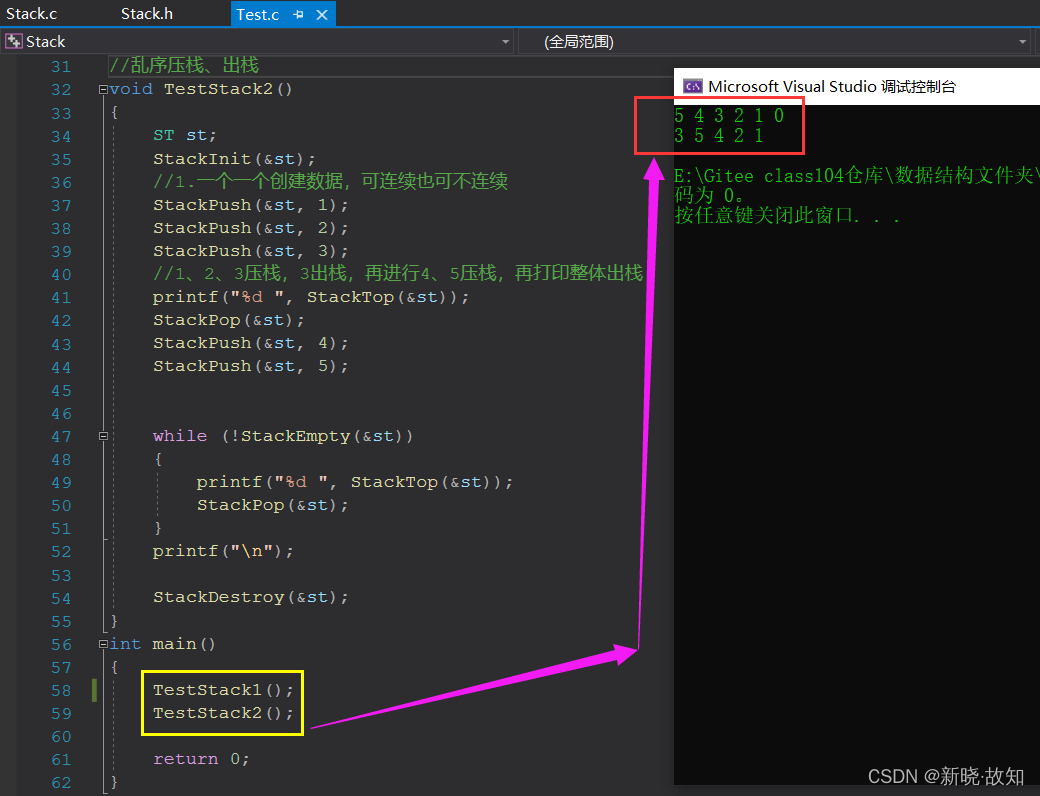目录
栈(动态版)的功能实现(<入栈,出栈>&<顺序,乱序>)测试示例:
后记:●由于作者水平有限,文章难免存在谬误之处,敬请读者斧正,俚语成篇,恳望指教!
《数据结构(C语言版)》实战项目之栈(动态版)的功能实现
——By 作者:新晓·故知
一、完整源码:
完整源码如下,欢迎复制测试指正!
栈(动态版)的功能实现(<入栈,出栈>&<顺序,乱序>)测试示例:
完整源码:
Test.c:
#include "Stack.h" //栈的测试 //按照顺序压栈、出栈 void TestStack1() { ST st; StackInit(&st); 1.一个一个创建数据,可连续也可不连续 //StackPush(&st, 1); //StackPush(&st, 2); //StackPush(&st, 3); //StackPush(&st, 4); //StackPush(&st, 5); //2.使用循环压栈创建数据 for (int i = 0; i < 6; ++i) { StackPush(&st, i); } while (!StackEmpty(&st)) { printf("%d ", StackTop(&st)); StackPop(&st); } printf("\n"); StackDestroy(&st); } //乱序压栈、出栈 void TestStack2() { ST st; StackInit(&st); //1.一个一个创建数据,可连续也可不连续 StackPush(&st, 1); StackPush(&st, 2); StackPush(&st, 3); //1、2、3压栈,3出栈,再进行4、5压栈,再打印整体出栈 printf("%d ", StackTop(&st)); StackPop(&st); StackPush(&st, 4); StackPush(&st, 5); while (!StackEmpty(&st)) { printf("%d ", StackTop(&st)); StackPop(&st); } printf("\n"); StackDestroy(&st); } int main() { TestStack1(); TestStack2(); return 0; }Stack.c:
#include "Stack.h" //栈的接口功能函数 //初始化 void StackInit(ST* ps) { assert(ps); ps->a = NULL; ps->top = 0; ps->capacity = 0; } //销毁 void StackDestroy(ST* ps) { assert(ps); free(ps->a); ps->a = NULL; ps->capacity = ps->top = 0; } //压栈 void StackPush(ST* ps, STDataType x) { assert(ps); //需要注意top的位置,取决于如何对top的初始化 //本程序top的初始化位置为0 //判断是否栈满,栈满即需要扩容 if (ps->top == ps->capacity) { int newCapacity = ps->capacity == 0 ? 4 : ps->capacity * 2; //此处的4是随机合理给定,无特别规定,*2是合理利用空间 ps->a = (STDataType*)realloc(ps->a, newCapacity * sizeof(STDataType)); //relloc给的是总的新空间的大小 if (ps->a == NULL) { printf("relloc fail\n"); exit(-1); } ps->capacity = newCapacity; } ps->a[ps->top] = x; ps->top++; } //出栈 void StackPop(ST* ps) { assert(ps); assert(ps->top > 0); --ps->top; } //判断栈是否为空 bool StackEmpty(ST* ps) { assert(ps); 写法1 //if (ps->top > 0) //{ // return false; //} //else //{ // return true; //} //写法2 return ps->top == 0; } //栈顶 STDataType StackTop(ST* ps) { assert(ps); assert(ps->top>0); return ps->a[ps->top - 1]; } //查看栈的数据 int StackSize(ST* ps) { assert(ps); return ps->top; }Stack.h:
#pragma once #include<stdio.h> #include<stdlib.h> #include<stdbool.h> #include<assert.h> //静态(不常用) //struct Stack //{ // int a[N]; // int top; //栈顶的位置 //}; //动态 typedef int STDataType; typedef struct Stack { STDataType* a; int top; //栈顶的位置 int capacity; //容量 }ST; //接口功能函数 //初始化 void StackInit(ST* ps); //销毁 void StackDestroy(ST* ps); //压栈 void StackPush(ST* ps, STDataType x); //出栈 void StackPop(ST* ps); //判断栈是否为空 bool StackEmpty(ST* ps); //栈顶 STDataType StackTop(ST* ps); //查看栈的数据 int StackSize(ST* ps);
二、栈的功能实现分析:
1.栈的概念及结构:
栈:一种特殊的线性表,其只允许在固定的一端进行插入和删除元素操作。 进行数据插入和删除操作的一端 称为栈顶,另一端称为栈底。 栈中的数据元素遵守后进先出 LIFO ( Last In First Out )的原则。
压栈:栈的插入操作叫做进栈 / 压栈 / 入栈, 入数据在栈顶 。出栈:栈的删除操作叫做出栈。出数据也在栈顶。
2.栈的实现方式:
栈的实现一般可以使用数组或者链表实现,相对而言数组的结构实现更优一些。因为数组在尾上插入数据的代价比较小。
3.栈的实现步骤:
(1)动态结构定义:
//动态 typedef int STDataType; typedef struct Stack { STDataType* a; int top; //栈顶的位置 int capacity; //容量 }ST;(2)栈的初始化:
//栈的接口功能函数 //初始化 void StackInit(ST* ps) { assert(ps); ps->a = NULL; ps->top = 0; ps->capacity = 0; }(3)压栈(入栈):
//压栈 void StackPush(ST* ps, STDataType x) { assert(ps); //需要注意top的位置,取决于如何对top的初始化 //本程序top的初始化位置为0 //判断是否栈满,栈满即需要扩容 if (ps->top == ps->capacity) { int newCapacity = ps->capacity == 0 ? 4 : ps->capacity * 2; //此处的4是随机合理给定,无特别规定,*2是合理利用空间 ps->a = (STDataType*)realloc(ps->a, newCapacity * sizeof(STDataType)); //relloc给的是总的新空间的大小 if (ps->a == NULL) { printf("relloc fail\n"); exit(-1); } ps->capacity = newCapacity; } ps->a[ps->top] = x; ps->top++; }(4)出栈:
//出栈 void StackPop(ST* ps) { assert(ps); assert(ps->top > 0); --ps->top; }(5)判断栈是否为空:
//判断栈是否为空 bool StackEmpty(ST* ps) { assert(ps); 写法1 //if (ps->top > 0) //{ // return false; //} //else //{ // return true; //} //写法2 return ps->top == 0; }(6)栈顶查找:
//栈顶 STDataType StackTop(ST* ps) { assert(ps); assert(ps->top>0); return ps->a[ps->top - 1]; }(7)查看栈的数据:
//查看栈的数据 int StackSize(ST* ps) { assert(ps); return ps->top; }(8)栈的销毁:
//销毁 void StackDestroy(ST* ps) { assert(ps); free(ps->a); ps->a = NULL; ps->capacity = ps->top = 0; }
栈的辨析:
栈顶top的位置:






